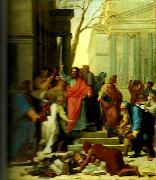|
||||||||||
|
|
||||||||||
|
la predication de saint paul a ephese Måleriet identifieringen:: 69475 Titta min galleri i Sverige |
la predication de saint paul a ephese se se |
|||||||||
|
|
||||||||||
|
1 | Föregående Konstnär Nästa Konstnär | |||||||||
|
|
||||||||||
| lesueur | ||||||||||
| Charles Alexandre Lesueur (Le Havre, January 1, 1778 - Le Havre, December 12, 1846) was a French naturalist, artist and explorer. Pictured here is the oil portrait by Charles Willson Peale of Charles-Alexandre Lesueur. The original hangs in the reading room of the of Ewell Sale Stewart Library in the Academy of Natural Sciences of Philadelphia. In 1801 he traveled to Australia as artist on the expedition of Nicolas Baudin. With François Peron he took over the duties as naturalist after the death of the expedition's zoologist Rene Mauge. Together they collected over 100,000 zoological specimens. Between 1815 and 1837 he lived in the United States In 1833, he visited Vincennes, Indiana where he sketched the first known drawing of Grouseland, the mansion of William Henry Harrison. The mansion is today a National Historic Landmark. In the years 1825-1837 Lesueur lived in New Harmony, Indiana, where he filled sketchbooks full of the finds discovered during the utopian adventure funded by his friend William Maclure. He drew the boat "Philanthropist", which arrived full of intellectuals who came to live in the small town of New Harmony, on the Wabash River. He took research trips and sketched the people and the small towns in the area. He was in New Harmony when Prince Maximilian, Prince of Wied-Neuweid, Germany, and artist Karl Bodmer came to spend five months there in 1832-1833. Prince Maximilian said of Bodmer "He had explored the country in many directions, was acquainted with everything remarkable, collected and prepared all interesting objects and had already sent considerable collections to France" (Elliott Johansen, p. 6) Indeed, LeSeur sent specimens of unique fish, animals and fossils, as well as artifacts he had dug from the Indian Mounds in New Harmony back to France, where they remain. LeSeur returned to France in 1837, only after his friends Thomas Say and Joseph Barabino had died and William MacClure had returned to Philadelphia, accompanied by many of his fine books. He had spent 21 years in the United States, but continued his scholarly studies and activities in France, where he resumed his occupation of artist-naturalist and began to catalogue his extensive research and artwork. At last, he was awarded the honor of Chevalier de l??Ordre Royal de la L??gion d'honneur for his long years of work in the sciences | ||||||||||
|
|
||||||||||
IntoFineArt Co,.Ltd.










